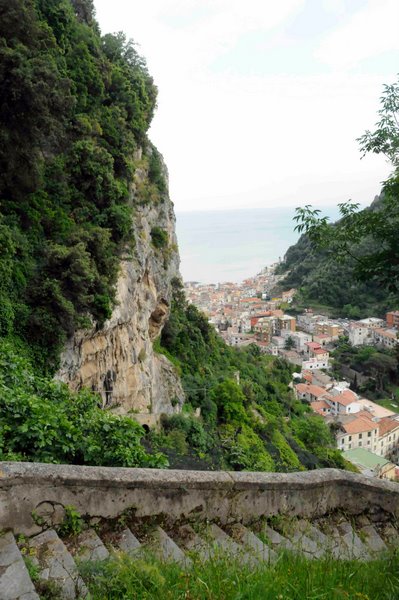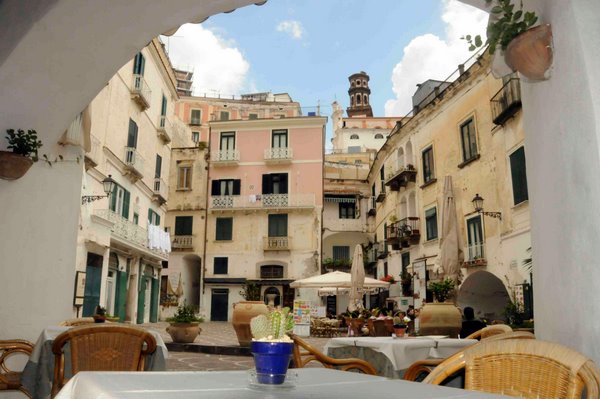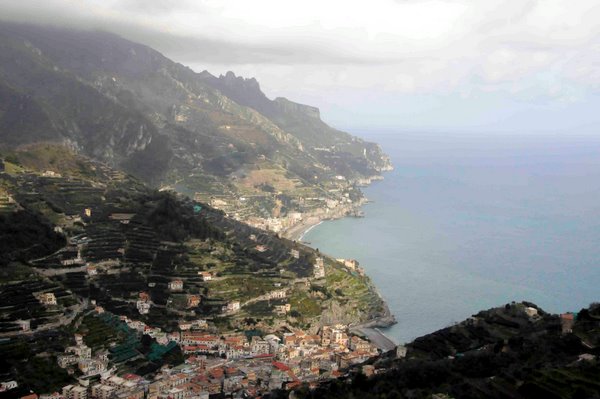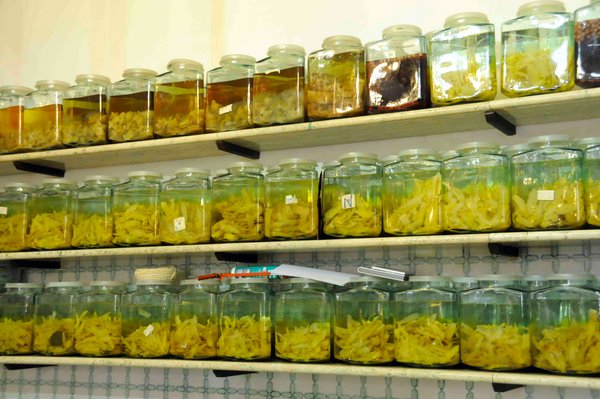 A small town on the Amalfi Coast, with a light rain on the roofs of the buildings built into the sides of the cliff, is enough to put every nerve in my body at ease. Sections of the Amalfi Coast are microclimates, thanks to the sheer rises and falls in altitude, producing gigantic waterfalls and caves filled with stalactites. After a 7-hour hike , it’s time to relax. I used to enjoy sitting by the waterfront with an umbrella in the rain smoking a good Tuscan cigar—the cigars made in Tuscany are tightly wound, producing a moist, refreshing flavor—but I’ve since begun to follow my parents’ example: no cigar, just the ocean and the rain. And an umbrella, of course. Simple and good, very good!
A small town on the Amalfi Coast, with a light rain on the roofs of the buildings built into the sides of the cliff, is enough to put every nerve in my body at ease. Sections of the Amalfi Coast are microclimates, thanks to the sheer rises and falls in altitude, producing gigantic waterfalls and caves filled with stalactites. After a 7-hour hike , it’s time to relax. I used to enjoy sitting by the waterfront with an umbrella in the rain smoking a good Tuscan cigar—the cigars made in Tuscany are tightly wound, producing a moist, refreshing flavor—but I’ve since begun to follow my parents’ example: no cigar, just the ocean and the rain. And an umbrella, of course. Simple and good, very good!
Two nights ago I dined at one of the best seafood restaurants on the Amalfi Coast, Osteria da Luisella. I hadn’t eaten there in three years, but the food was as good as I remembered. It isn’t cheap, but it is an example of the finer things in life. The seafood on the Amalfi Coast is intensely fresh, usually caught and cooked the same day, and I’m never able to separate the memories of the flavors from the memories of the cliffs.
 At Osteria da Luisella, the house wine was an excellent Falanghina (12 euro), a white grape prevalent in the region. I started with the Fritto Misto (15 euro), a very lightly battered and fried selection of shrimp, calamari, and small fish. Meant to be eaten with your hands, everything on the plate can be eaten whole (Kristin prefers it if I eat the heads off the fish and shrimp). The calamari was tender, the fish tasted like the sea, but the shrimp were the best: they were so sweet! Next, we had the Risotto di Mare (25 euro), a risotto made for two people, with mussels, clams, calamari, shrimp, and a little parsley. We ate at the edge of the piazza beneath an arch; the towering cliffs and an artfully lit church were our view. And, of course, no meal on the Amalfi Coast is complete without limoncello.
At Osteria da Luisella, the house wine was an excellent Falanghina (12 euro), a white grape prevalent in the region. I started with the Fritto Misto (15 euro), a very lightly battered and fried selection of shrimp, calamari, and small fish. Meant to be eaten with your hands, everything on the plate can be eaten whole (Kristin prefers it if I eat the heads off the fish and shrimp). The calamari was tender, the fish tasted like the sea, but the shrimp were the best: they were so sweet! Next, we had the Risotto di Mare (25 euro), a risotto made for two people, with mussels, clams, calamari, shrimp, and a little parsley. We ate at the edge of the piazza beneath an arch; the towering cliffs and an artfully lit church were our view. And, of course, no meal on the Amalfi Coast is complete without limoncello.
 Today I ventured into the town of Amalfi. I am afraid the town has lost its way. It is overrun with tourists, and the pristine seaside is marred by large ferries and cruise ships. Its once peaceful piazza is now crowded by knick-knack stores that all sell the same oversized, tasteless lemons and ceramic tiles (I actually found several with “Made in China” written on the back). Though I’ve tried multiple times, I have never had a good meal in Amalfi. I highly suggest staying in one of the smaller, lesser-known towns during your vacation on the Amalfi Coast.
Today I ventured into the town of Amalfi. I am afraid the town has lost its way. It is overrun with tourists, and the pristine seaside is marred by large ferries and cruise ships. Its once peaceful piazza is now crowded by knick-knack stores that all sell the same oversized, tasteless lemons and ceramic tiles (I actually found several with “Made in China” written on the back). Though I’ve tried multiple times, I have never had a good meal in Amalfi. I highly suggest staying in one of the smaller, lesser-known towns during your vacation on the Amalfi Coast.
However, Amalfi is certainly good at making limoncello. The lemons grown on the cliffs are intensely flavorful. The “limoncello factory” I visited wasn’t very interesting (though it offered a free tasting) because the process of production is so simple; all there is to see is jars full of fermenting lemons. Many Italians make their own limoncello. Below is a recipe that I received during a trip in southern Puglia. The tricky part, for Americans, is finding pure grain alcohol, aka Everclear.
Limoncello Recipe (recipe can be doubled or tripled accordingly):
Ingredients:
 1 Liter of grain alcohol (if you can’t find this, use vodka),
1 Liter of grain alcohol (if you can’t find this, use vodka),
8 high-quality lemons
1 Liter of water (do not use more water than alcohol)
2 ½ cups sugar
(You’ll also need a large, sterilized jar with a lid to store the mixture)
1) Peel lemons, being careful to remove all of the pith. Place lemon peels and alcohol in the jar. Cover and store for 40 days.
2) On day 40, put water and sugar in a pot and boil for 5 minutes (making a syrup). Let the syrup cool. Meanwhile, remove all of the lemon peels from the alcohol (if you’re having trouble, try straining it using a coffee filter). Combine alcohol and syrup. Store for another 40 days.
3) Now your limoncello is ready. Pour it into an attractive bottle and put it in the freezer. Limoncello is best cold. The longer the limoncello ages, the smoother it tastes.
It’s always sad to leave the Amalfi Coast. Fortunately, I’m on my way to one of my favorite Italian cities: Naples.






Comments